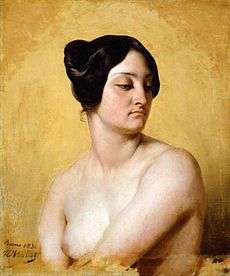Horace Vernet


Émile Jean-Horace Vernet (30 June 1789 – 17 January 1863) was a French painter of battles, portraits, and Orientalist subjects.
Biography

Vernet was born to Carle Vernet, another famous painter, who was himself a son of Claude Joseph Vernet. He was born in the Paris Louvre, while his parents were staying there during the French Revolution. Vernet quickly developed a disdain for the high-minded seriousness of academic French art influenced by Classicism, and decided to paint subjects taken mostly from contemporary life. During his early career, when Napoleon Bonaparte was in power, he began depicting the French soldier in a more familiar, vernacular manner rather than in an idealized, Davidian fashion. Some of his paintings that represent French soldiers in a more direct, less idealizing style, include Dog of the Regiment, Trumpeter's Horse, and Death of Poniatowski.
He gained recognition during the Bourbon Restoration for a series of battle paintings commissioned by the duc d'Orleans, the future King Louis-Philippe. Critics marvelled at the incredible speed with which he painted.[2] Many of his paintings made during this early phase of his career were "noted for their historical accuracy as well as their charged landscapes."[3] Examples of paintings in this style include his Four Battles series: The Battle of Jemappes (1821), The Battle of Montmirail (1822), The Battle of Hanau (1824), and The Battle of Valmy (1826).
Over the course of his long career, Horace Vernet was honoured with dozens of important commissions. King Louis-Philippe was one of his most prolific patrons.[2] His depictions of Algerian battles, such as the Capture of the Smahla and the Capture of Constantine, were well-received, as they were vivid depictions of the French army in the heat of battle. After the fall of the July Monarchy during the Revolution of 1848, Vernet discovered a new patron in Napoléon III of France. He continued to paint representations of the heroic French army during the Second Empire and maintained his commitment to representing war in an accessible and realistic way. He accompanied the French Army during the Crimean War, producing several paintings, including one of the Battle of the Alma, which was not as well received as his earlier paintings. One well known and possibly apocryphal anecdote maintains that when Vernet was asked to remove a certain obnoxious general from one of his paintings, he replied, "I am a painter of history, sire, and I will not violate the truth," hence demonstrating his fidelity to representing war truthfully.
Vernet died in his hometown of Paris in 1863.
Literary references
In Arthur Conan Doyle's Sherlock Holmes story "The Adventure of the Greek Interpreter" Holmes claims to be related to Vernet, stating, "My ancestors were country squires... my grandmother... was the sister of Vernet, the French artist.", without further clarifying whether this is Claude Joseph Vernet, Carle Vernet, or Horace Vernet.
Gallery
 The Battle of Valmy (1826)
The Battle of Valmy (1826)- Polish Prometheus (1831)
 Hunting in the Pontine Marshes (1833)
Hunting in the Pontine Marshes (1833) Scene from the Mexican Expedition in 1838 (1841)
Scene from the Mexican Expedition in 1838 (1841)
 Study of Olympe Pélissier as Judith (1830)
Study of Olympe Pélissier as Judith (1830) The Taking of the Malakoff Redoubt (1858)
The Taking of the Malakoff Redoubt (1858) An Algerian Lady Hawking
An Algerian Lady Hawking Siege of Saragossa (Vernet) (1819)
Siege of Saragossa (Vernet) (1819)
References
- ↑ "Washington and Lee University". Home.wlu.edu. Retrieved 2012-06-11.
- 1 2 Ruutz-Rees, Janet E. (Janet Emily) (1880). Horace Vernet. New York: Scribner and Welford.
- ↑ The Art of War[s]: Paintings of Heroes, Horrors and History - Chase Maenius
Further reading
- Dayot, Armand (1898). Les Vernet : Joseph--Carle--Horace. Paris: A. Magnier.
- Harkett, Daniel and Katie Hornstein, eds, (2017). Horace Vernet and the Thresholds of Nineteenth-Century Visual Culture. Dartmouth College Press/University Press of New England
- Ruutz-Rees, Janet E. (Janet Emily) (1880). Horace Vernet. New York: Scribner and Welford.
External links
![]() Media related to Horace Vernet at Wikimedia Commons
Media related to Horace Vernet at Wikimedia Commons
- Gallery of Paintings by Horace Vernet
- Anne S. K. Brown Military Collection, Brown University Library numerous military lithographs and some original drawings by Horace Vernet.
- Works by Horace Vernet at Open Library